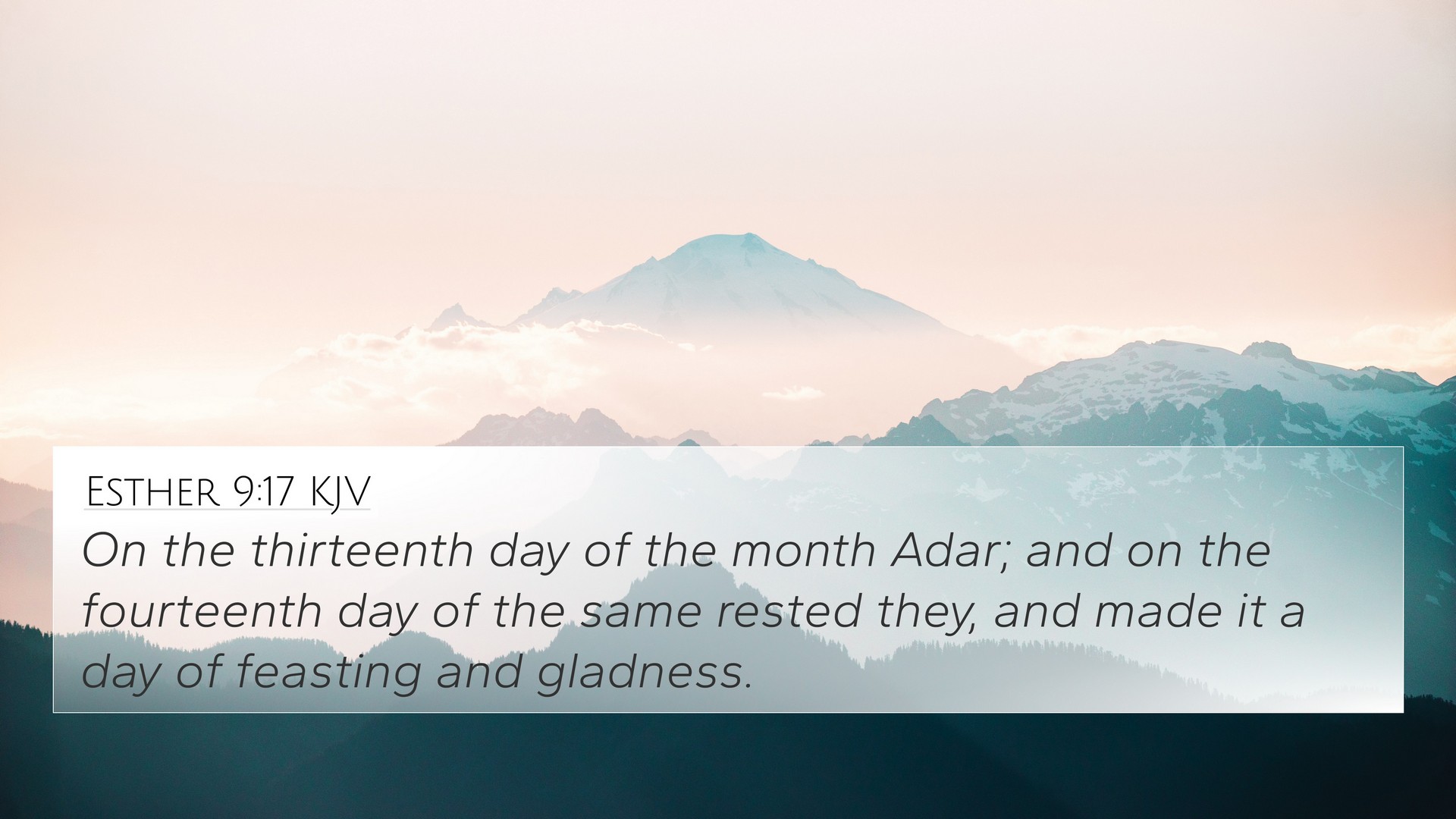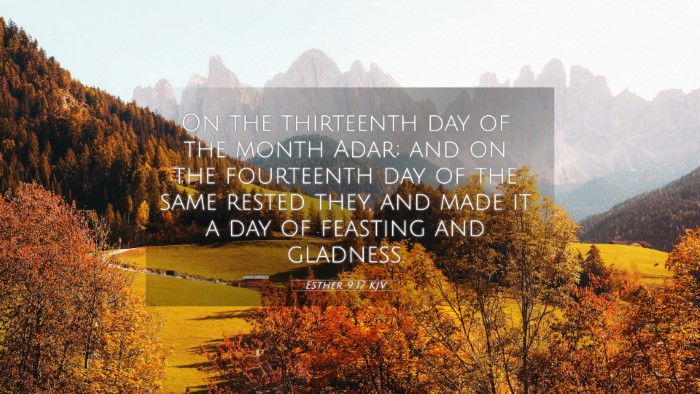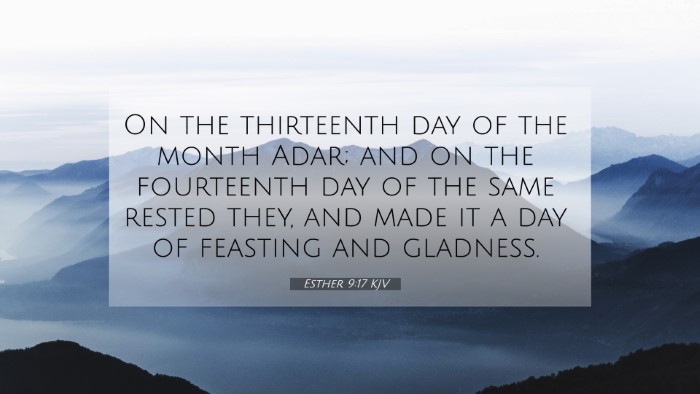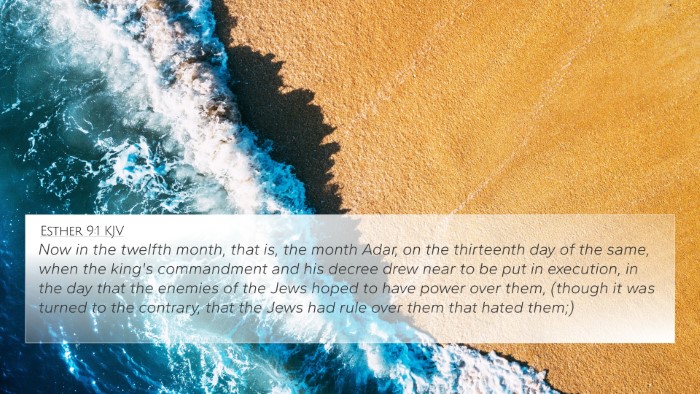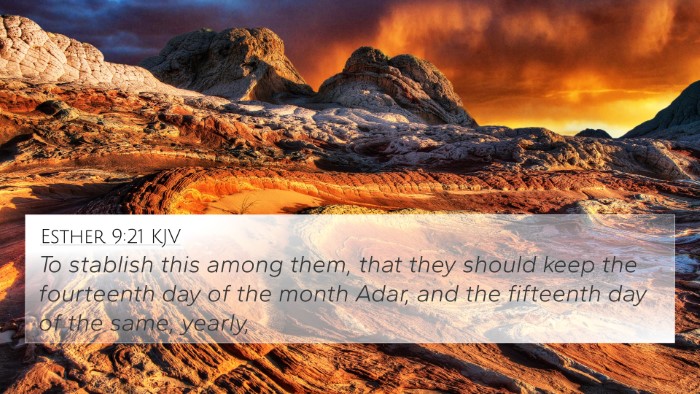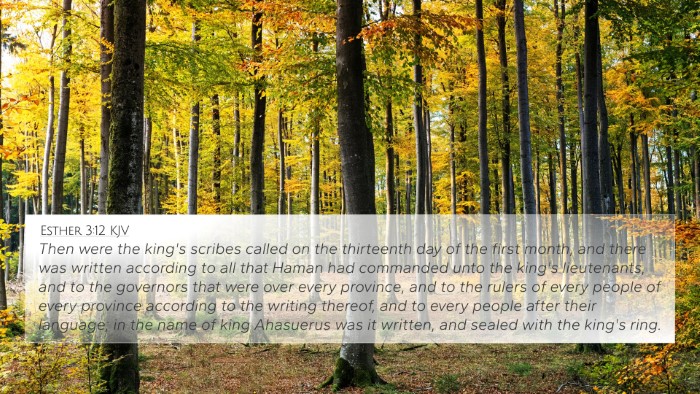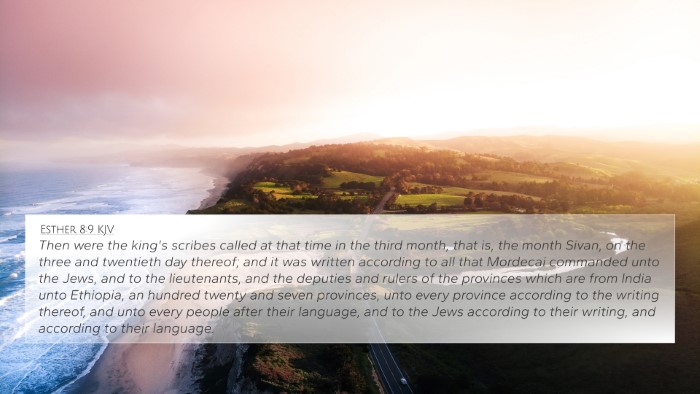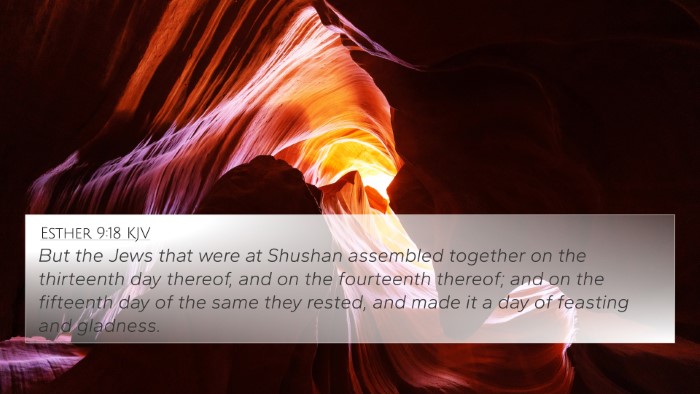Understanding Esther 9:17
Esther 9:17 states: "This was on the thirteenth day of the month Adar. And on the fourteenth day, they rested and made it a day of feasting and gladness." This verse highlights the conclusion of a significant event in Jewish history—the deliverance from oppression, culminating in the celebration of what would become the festival of Purim.
Key Themes in Esther 9:17
- Celebration of Deliverance: The verse encapsulates a moment of relief and joy after a period of turmoil.
- The Importance of Rest: Their resting on the fourteenth day signifies a time for reflection and gratitude.
- Establishment of Tradition: This verse marks the origins of the Jewish festival of Purim, a festival of joy and remembrance.
Bible Verse Cross-References
Esther 9:17 is intricately tied to several other verses in the Bible, presenting a rich tapestry of meaning and celebration of God’s providence:
- Esther 9:1: Discusses the turning of events on the thirteenth day, establishing the context of deliverance.
- Esther 9:18: Describes the ongoing celebration of Purim and its relevance for future generations.
- Exodus 12:14: Establishes the precedent of commemorating significant deliverance events, as seen in Passover.
- Psalm 30:11-12: Expresses how God turns mourning into dancing, echoing the joy found in deliverance.
- Isaiah 61:3: Promises comfort and joy for those who mourn, connecting to the emotional state during Purim.
- John 16:20: Jesus speaks about turning sorrow into joy, paralleling the transformation experienced by the Jews.
- Philippians 4:4: Encouragement to rejoice always, reminiscent of the celebratory nature of Purim.
Commentary Insights
Drawing from the insights of renowned public domain commentators:
Matthew Henry's Commentary
Matthew Henry emphasizes the significance of the thirteenth day as a day of battle and conflict, resulting in their victory over enemies. He notes that the feast celebrated on the fourteenth day serves as a profound reminder of divine intervention and sovereignty in times of peril.
Albert Barnes' Notes on the Bible
Albert Barnes highlights the joy felt by the Jewish people following their deliverance. He points out that the establishment of the feast signifies the need for remembrance and thanksgiving in the face of danger. This passage illustrates how God’s providential hand governs history.
Adam Clarke's Commentary
Adam Clarke elaborates on the customs surrounding the observance of Purim. He discusses the importance of feasting and sharing joy within the community, underscoring the collective responsibility to remember and celebrate divine protection and deliverance.
Thematic Bible Verse Connections
This verse creates thematic connections across the Bible, encouraging a deeper understanding of God’s purpose and provision throughout scripture:
- Deliverance and Celebration: The theme of deliverance is prevalent throughout the Old Testament, seen in events like the Exodus (Exodus 14) and the return from Babylonian exile (Ezra 1).
- Community and Remembrance: The practice of feasting and community bonding is echoed in verses focused on communal celebrations (Leviticus 23:39-41).
- God’s Sovereignty: The realization of God’s sovereignty is a connecting thread, illustrated well in Psalms (Psalm 46:10) and prophetic writings (Isaiah 14:27).
Tools for Bible Cross-Referencing
When studying verses like Esther 9:17, utilizing various tools for Bible cross-referencing enhances comprehension. Here are some resourceful methods:
- Bible Concordance: A comprehensive list of terms used throughout the Bible, making it easier to locate related scriptures.
- Bible Cross-Reference Guide: Guides that help find connections between verses that may not be directly linked but share similar themes.
- Bible Chain References: A method of study where verses are linked in a chain, highlighting the thematic relationships between biblical texts.
- Digital Bible Study Tools: Online resources and software that provide automatic cross-referencing and thematic connections.
How to Use Bible Cross-References
To effectively study cross-references, consider the following steps:
- Identify Key Themes: Determine the central themes of the verse you are studying and seek out similar themes in other scriptures.
- Use a Concordance: Look up keywords and phrases in a Bible concordance to find related verses.
- Take Notes: As you find connections, note down thoughts or questions that arise to deepen understanding.
- Engage in Group Studies: Discuss these connections in a study group to explore diverse interpretations and insights.
Conclusion
Esther 9:17 is not only a pivotal verse highlighting joy and deliverance but also serves as a doorway to understanding the broader narrative of God’s faithfulness throughout the scriptural canon. By linking this verse with others through thoughtful cross-referencing, believers can experience a richer understanding of scripture and its application in their lives.
